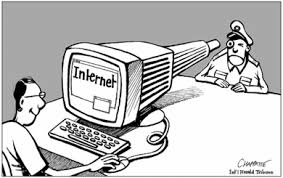5 June 2016 – How should you conceptualize the Internet?
Well, let’s ask the United States’ National Security Agency circa 2007. The crew at MuckRock, a media outfit that helps people file requests for governmental information through the Freedom of Information Act (I have used them to crowdsource information on the Syrian war imbroglio), recently highlighted a wonderfully wacky guide to Internet research published by the ultra-secret intelligence agency that year. The text does not disappoint.
Michael Morisy, the site’s founder, first noticed a record of the guide, called Untangling the Web, on Google Books. He filed a request for it in April 2013 and the agency released the 650-page tome in its entirety a month later. (It’s probably fair to say that Morisy is one of the last people in the world to need a guide to Internet research, but that’s neither here nor there.)
Though much has changed in the decade since the document in question came to be, the NSA book is still worth a perusal. Its authors blend ancient history, mythology, postmodern fiction, psychoanalytics, practical tips for computer users, and more. In the preface alone, the Persian scholar Sahib Isma’il b. ‘Abbad, the Roman poet Ovid, and the Argentinian literary genius Jorge Luis Borges all make an appearance. Not bad for an opening act.
If you’re going to take the dive (and I suggest you do), prepare for the nerdiest of reading experiences. As MuckRock editor JPat Brown puts it: “you don’t have to go very far before this takes a hard turn into ‘Dungeons and Dragons campaign/Classics major’s undergraduate thesis’ territory.” That observation hits the nail on the head.
Its history of search and using search/context (starting on page 12 and running a few hundred pages) is fascinating.
I’ll highlight one excerpt from the book. Here’s a meditation on the Internet, per the guide’s conclusion:
“no one is out of reach of this powerful, invasive technology. We change the world with our technology and we, in turn, are altered by that same technology. It remains to be seen where our technology leads us, whether into an ‘endless frontier’ or, more ominously, into a ‘cemetery of dead ideas.’”
For reference: that “endless frontier” is a nod to Vannevar Bush, one of America’s leading 20th century scientific thinkers, and the “cemetery of dead ideas” is a reference to Miguel de Unamuno, the Spanish essayist, novelist, poet, playwright, philosopher, professor of Greek and Classics, rector at the University of Salamanca … yeah, one of those infernal polymaths.
Anyway, I recommend the guide to anyone looking for some entertainment over a lazy weekend. In the meantime, I’ll be quaffing some excellent white wine and puzzling over that Minotaur-or-centaur image on page three.
